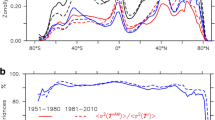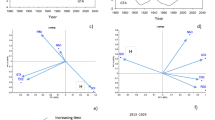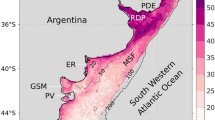Abstract
Based on data from the Comprehensive Ocean-Atmosphere Data Set (COADS), objective analyses of the monthly mean sea surface temperature (SST) were prepared at GFDL for each month of the 110-year period 1870–1979. Time series of various indices characterizing the SST anomalies averaged over the eastern equatorial Pacific (EEP), the tropical oceans and the world ocean are presented for monthly, yearly and decadal time-averaging periods. Global correlations maps are given for each decade of the 1870–1979 period. They show the spatial connections between the monthly SST anomalies in the EEP and in other parts of the world ocean and how these connections vary for the different decades. On the intermonthly time scale the SST anomalies in the EEP and those in the tropical and world oceans are found to be highly correlated, with maximum correlations values of 0.91 at zero lag for the tropical oceans during the 1950–1959 decade and 0.81 for the world ocean during the 1970–1979 decade. Positive correlation values of r⩾0.36 persist on average from about 4 months before to about 8 months after the EEP anomalies occur. There is a clear tendency for the tropical and world ocean anomalies to lag behind the EEP anomalies. Comparing different oceans, we find the tendency for the tropical SST anomalies in the Indian and Atlantic Oceans to lag behind those in the EEP region by about 1 and 3 months, respectively. On the interannual time scale the EEP anomalies are also well correlated with those in the other regions, having an average correlation of 0.84 for the tropical oceans and of about 0.7 for the world ocean.
Similar content being viewed by others
References
Bjerknes J (1964) Atlantic air-sea interaction. Adv Geophys 10:181
Bjerknes J (1969) Atmospheric teleconnections from the Equatorial Pacific. Mon Weather Rev 97:163–172
Chao JP (1977) Large-scale air-sea interaction and long-range weather forecasting. Scientia Atmospherica Sinica 1:223–233
Folland CK, Parker DE, Kates FE (1984) Worldwide marine temperature fluctuations, 1856–1981. Nature 310:670–673
Halpern D, Hayes SP, Leetmaa A, Hansen DV, Philander SGH (1983) Oceanographic observations of the 1982 warming of the tropical Eastern Pacific. Science 221:1173–1175
Horel JD, Wallace JM (1981) Planetary-scale atmospheric phenomena associated with the southern oscillation. Mon Weather Rev 109:813–829
Jones PD, Wigley TML, Wright PB (1986) Global temperature variations between 1861 and 1984. Nature 322:430–434
Lau N-C (1985) Modeling the seasonal dependence of the atmospheric response to observed El Niños in 1962–76. Mon Weather Rev 113:1970–1996
Lau N-C, Oort AH (1985) Response of a GFDL General Circulation Model to SST fluctuations observed in the tropical Pacific Ocean during the period 1962–1976. In: Nihoul JCJ (ed) Coupled ocean-atmosphere models pp 289–302
Levitus S (1982) Climatological atlas of the world ocean. NOAA Professional Paper No 13, 163 pp (+ 17 microfiches), US Government Printing Office, Washington DC
Lukas R, Hayes SP, Wyrtki K (1984) Equatorial sea level response during the 1982–83 El Niño. J Geophys Res 89:10425–10430
Namias J (1983) Short period climatic variations. Collected works of J. Namias 1975 through 1982, vol III. University of California, San Diego, pp 393
Namias J (1985) New evidence for relationships between North Pacific atmospheric circulation and El Niño. Tropical OceanAtmosphere Newsletter 30:1
Oort AH, Pan YH (1984) The observed effects of tropical heating over the east Pacific on global climate variations. Acta Oceanologica 3:488–498
Oort AH, Pan YH (1985) Diagnosis of historical ENSO events. Proceedings of the First WMO Workshop on the diagnosis and prediction of monthly and seasonal atmospheric variations over the globe, 29 July–2 August, 1985, College Park, USA
Oort AH, Vonder Haar TH (1976) On the observed annual cycle in the ocean-atmosphere heat balance over the Northern Hemisphere. J Phys Oceanogr 6:781–800
Oort AH, Pan YH, Reynolds RW, Ropelewski CF (1987) Historical trends in the surface temperature over the oceans based on the LOADS. Climate Dyn 2:29–38
Pan YH (1983) The teleconnection between typhoon frequency on the western Pacific and the sea surface temperature of the eastern equatorial Pacific. Kexue Tonbao 26:157–160
Pan YH, Oort AH (1983) Global climate variations connected with sea surface temperature anomalies in the eastern equatorial Pacific for the 1958–73 period. Mon Weather Rev 111:1244–1258
Philander SGH, Rasmusson EM (1985) The Southern Oscillation and El Niño. Adv Geophys 28A:197–215
Quinn WH, Neal VT, Antuñez de Mayolo S (1987) El Niño occurrences over the past four and a half centuries. J Geophys Res 92:14449–14461
Ramage CS, Hori AM (1981) Meteorological aspects of El Niño. Mon Weather Rev 109:1827–1835
Rasmusson EM, Wallace JM (1983) Meteorological aspects of the El Niño/Southern Oscillation. Science 222:1195–1202
Slutz RJ, Lubker SJ, Hiscox JD, Woodruff SD, Jenne RL, Joseph DH, Steurer PM, Elms JD (1985) Comprehensive ocean-atmosphere data set; Release 1. NOAA Environmental Res Lab, Climate Res Progr, Boulder CO, pp 268
Spiegel MR (1961) Statistics. Schaum's outline series in mathematics, McGraw Hill, New York, pp 359
Toole JM (1985) Near equatorial CTD observations at 85° W in October 1982. J Geophys Res 90:929–933
Trenberth KE (1984) Some effects of finite sample size and persistence on meteorological statistics. Part 1: Autocorrelations. Mon Weather Rev 112:2359–2368
Wallace JM, Jiang Q (1987) On the observed structure of the interannual variability of the atmosphere/ocean climate system. In: Cattle H (ed) Atmospheric and oceanic variability, Royal Meteorol Soc, Bracknell, England, pp 17–43
Woodruff SD (ed) Proceedings of a LOADS Workshop, NOAA Tech Memo ERL ESG-23, pp 218
Woodruff SD, Slutz RJ, Jenne RL, Steurer PM (1987) A comprehensive ocean-atmosphere data set. Bull Am Meteorol Soc 68:1239–1250
Wright PB (1986) Problems in the use of ship observations for,the study of interdecadal climate changes. Mon Weather Rev 114:1028–1034
Wyrtki K (1974) Sea level and the seasonal fluctuations of the equatorial currents in the western Pacific Ocean. J Phys Oceanogr 4:91–103
Wyrtki K, Firing E, Halpern D, Knox R, McNally GJ, Patzert WC, Stroup ED, Taft BA, Williams R (1981) The Hawaii to Tahiti shuttle experiment. Science 211:22–28
Author information
Authors and Affiliations
Rights and permissions
About this article
Cite this article
Hong Pan, Y., Oort, A.H. Correlation analyses between sea surface temperature anomalies in the eastern equatorial Pacific and the world ocean. Climate Dynamics 4, 191–205 (1990). https://doi.org/10.1007/BF00209521
Received:
Accepted:
Issue Date:
DOI: https://doi.org/10.1007/BF00209521




